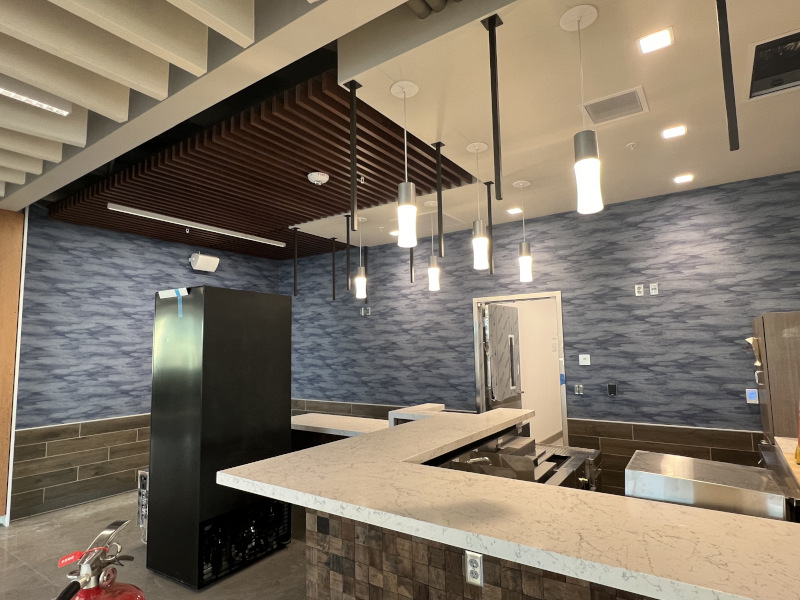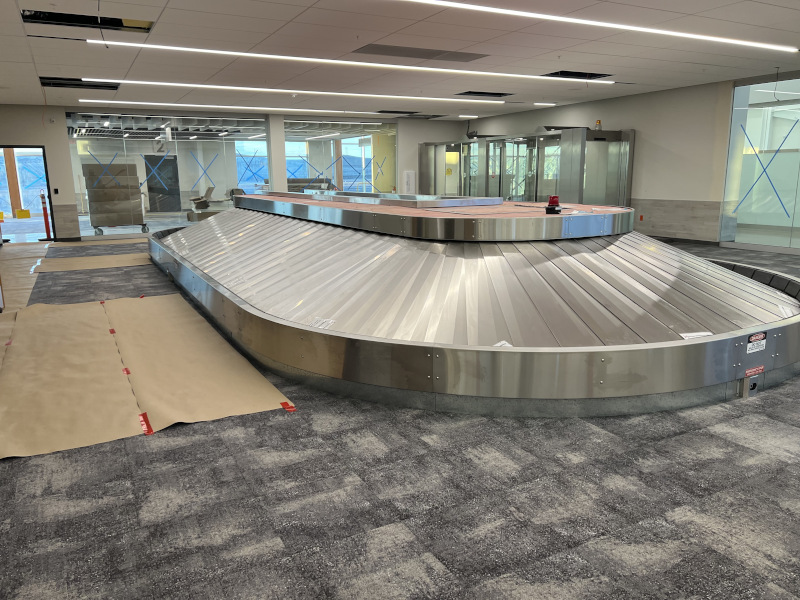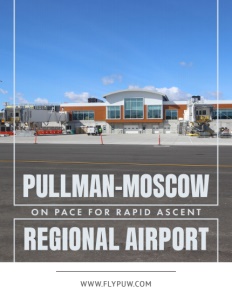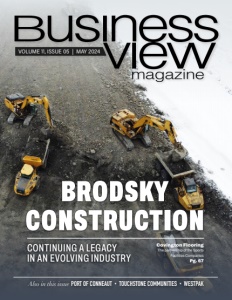Pullman-Moscow Regional Airport
On Pace for Rapid Ascent
An economic throughway for two key communities
In a relatively short time frame, Pullman-Moscow Regional Airport (PUW) has transformed into one of the most dynamic airfields in the Northwest. Located in Whitman County, Washington, four miles west of Moscow, Idaho, the airport serves as a vital throughway for commercial and general aviation, as well as chartered flights for college athletic programs.
While the airport began operations in 1932 to service the alfalfa and wheat industries, it quickly became synonymous with college sports, especially football, when fans traveled to watch Washington State face California in the ’32 National Championship. Nowadays, college charters filled with basketball clubs and football teams make up a chunk of the air traffic, but that’s not all.
PUW is a full-service airport and fixed-base operator, now boasting a shiny new runway that has taken the airfield to new heights. And for Tony Bean, Executive Director at Pullman-Moscow, the hustle and bustle is about more than economic growth or flashy new infrastructure; his job entails much more.
For example, PUW’s new runway project ensured the local and international supply chain remained connected to the Pullman-Moscow area.
“We do not have an interstate. We do not have a waterway. We do not have a railway. But everything that is produced in the Palouse [region] is global,” Bean says, highlighting the area’s key economic dilemma and where the airport fits into the solution.
The team at Pullman-Moscow Airport has already made everyone’s lives better with a few gargantuan upgrades, and some massive plans are in the works for the near future, too.

Record growth
PUW’s brand-new runway has opened up a wealth of opportunities, but its inception was a bit complicated. As Bean explains, the original runway was set up for 19-seat aircrafts, not the much larger plans that are common today. As this strip got older, the Federal Aviation Administration (FAA) encouraged the airport to kickstart an upgrade.
Without the upgrades, PUW would lose its funding, meaning some serious consequences for the surrounding communities. For example, Whitman County is the largest wheat-producing county in the United States. Losing Pullman-Moscow would mean a massive detriment to that industry, as well as the greater global economy that relied on wheat exported from Washington.
As PUW sized up a complete overhaul of the terminal building, Bean and his team decided the runway had to come first. Now it spans 7,100 feet long and 150 feet wide, with a full instrument landing system and a standard runway visual range.
“If you can’t land the airplane, you don’t need the building,” Bean says matter-of-factly.
Post COVID-19 pandemic, with the runway now in place, traffic at Pullman-Moscow has skyrocketed. The airport saw significant growth in 2021 and 2022, before hitting its stride last year.
“We had record growth in 2023, with over 75,000 people getting on an aircraft out of Pullman-Moscow Regional,” says Bean, noting a total traffic tally of 150,000 passengers.
On the commercial side, Bean notes additional growth and “very strong” employment numbers. In the airline industry, there’s a concept called “load factor,” which measures the percentage of available seating capacity filled by passengers. PUW maintains a high load factor, even as the aviation world returns to normal. Pullman-Moscow is facing some frequency decreases amid a pilot shortage and a sluggish rebound from COVID, but, overall, things are trending in the right direction.
“It’s getting better with time,” says Bean.
And believe it or not, the $158-million runway realignment was just the first phase of several key renovations to Pullman-Moscow Airport’s facilities.
A game-changing new terminal
A new terminal was always in the cards, and Bean finally implemented that massive upgrade. As the world distanced itself from the pandemic, the federal government poured in funding that, combined with internal resources at PUW, made a massive new terminal possible. Opening in May, the building is a thing of beauty.
Spanning 47,000 square feet, this building is loaded with fine amenities. For the first time ever, the airport will have full concessions, plus full baggage systems and two boarding bridges, allowing passengers to remain indoors when they board their flight. There are large glass windows, new seating inside the building, and a brand-new parking lot with anti-icing infrastructure built into it.
The terminal was designed in consultation with an advisory committee composed of multiple leaders from universities, as well as surrounding county advisors and state officials from both Idaho and Washington.
“All of it is thought about with the capability of the public to come through and just be at ease,” says Bean, emphasizing the dynamic flow of the airport’s new terminal.
Bean crunched the numbers in planning for this project, starting with an estimation of how many charters the airport runs during peak hours. Pullman-Moscow is unique in that its peak season is during the traditional school year, as much of its traffic comes via athlete charters from Washington State University and the University of Idaho. Much of the construction and planning was performed with that niche in mind.
“We’re unique in the fact that we run athletic charters and commercial traffic through the same structure at the same time,” explains Bean. “It’s a very normal thing for us. It’s not normal for most markets.”
Overall, the terminal construction project, including the revamped parking lot, cost $90 million. Interestingly, the project’s construction management company received permission from the FAA for contractors to inform on design as the project progressed.
Enabling contractor input helped make the project cost-conscious, collaborative, and efficient.
“I think we’re the second smaller airport in the state of Washington to go through the process,” says Bean. “Tri-Cities [Airport] did it. The bigger airports do it, but they’re not using federal funds, typically.”
Best of all, this new terminal at PUW was built on a completely different site than the old terminal. That meant the entire airport could operate as usual while construction wrapped up. Once everything is ready, all the equipment, such as x-rays and rental cars, can be swapped over to the new terminal, where business carries on as usual.
“The next morning will open up just like we were there, and we’ll start, but we’ll have additional capabilities,” says Bean.
That seamless swap is rare nowadays. It’s also an economic godsend for Pullman-Moscow and the surrounding area, as commercial and corporate flights continue.

Filling old space with new business
The old terminal building, which spans about 8,000 square feet, will soon be up for grabs. Ideally, Bean hopes to find a new business to fill that space, such as a cargo operator to use the existing infrastructure to move goods and services.
On an economic level, the new terminal will have a massive impact, especially since the design was left open-ended. PUW hopes to one day expand the new terminal even more, adding more apron space and establishing a strong long-term base for commercial aviation.
Both Pullman, Washington, and Moscow, Idaho, are growing in population, too.
“We’re seeing a lot of telework-type folks after the pandemic,” says Bean. “And we’re hosting a lot of people now where they want to live in Pullman or Moscow, where it’s smaller towns but they’re still working in Seattle or Portland.”
Recently, PUW has been looped into the master planning process of the airport’s immediate surrounding area. Several entities, including multiple manufacturing companies, have expressed interest in developing the nearby corridor and getting access to the airport.
“As the airport grows, it’s getting a lot of notice,” says Bean.
Soaring into 2025
Now that Pullman-Moscow Regional Airport is equipped with a top-of-the-line runway, Bean can initiate dialogues that he otherwise wouldn’t have been able to. The new facilities make a darn good sales pitch for any corporate entity hoping to bring its business to the Palouse region.
“With the previous runway, we just couldn’t have that conversation because we didn’t meet the standards for a lot of aircraft,” he says. So the first [priority] is what we can do to try to get the communities in a position where they can recruit additional air service.”
Beyond that, Bean is prioritizing a comprehensive look inward, scoping out where new opportunities lie for commercial and general aviation. That includes how PUW fits into the greater local economic picture.
“It’s going to be comprehensive, moving the airport into the future,” says Bean, “as we move forward with both community growth and being able to support our communities, our universities, the counties, the cities, and those business entities that are located in Pullman and Moscow.”
To take it a step further, Bean wants to support local residents, the folks most directly invested in this municipal airport.
“Local investment is huge,” states Bean. But it’s a benefit that they earned, they paid for. They deserve to have the best experience that we can create.”
AT A GLANCE
Pullman-Moscow Regional Airport
What: A newly renovated commercial and general aviation airport facilitating some of the most important air travel in the Northwestern United States
Where: Whitman County, Washington
Website: https://www.flypuw.com/



